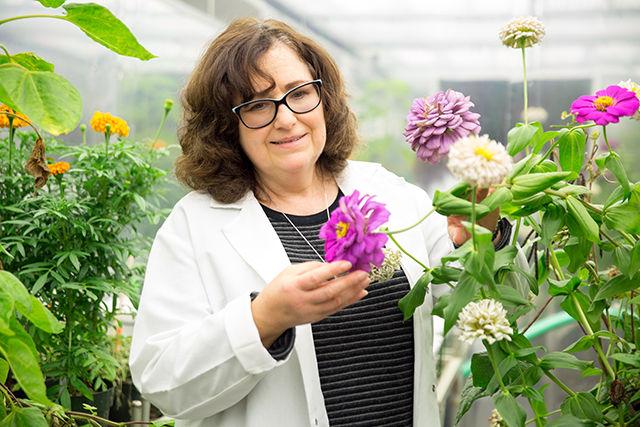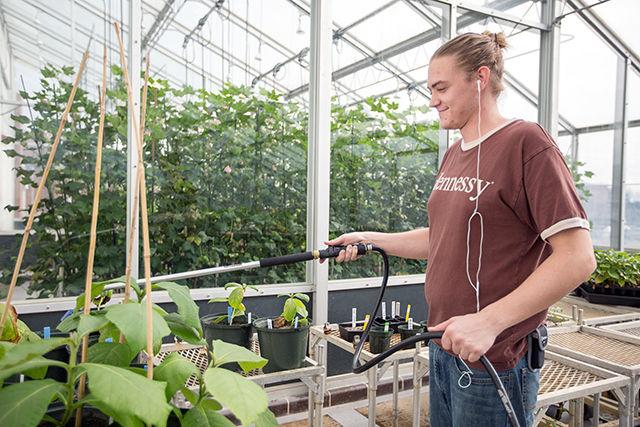Nestled between the wings of Gardner Hall is the Phytotron building. Following the pathway, one would find the entrance into an oasis of horticultural research. Inside, growth chambers encapsulate plants, essentially operating as hotel rooms.
The facility is as mystifying as its inhabitants, ranging from plants to pathogens. In the Phytotron, occupants change as fast as the seasons, although there are exceptions.
“The Clover plants, some of which are ozone sensitive or resistant, have been here since the seventies,” said Carole Saravitz, director of the Phytotron and 1990 horticulture alumna. “We keep propagating them. We work like a hotel here; the chambers come as available.”
The doors of Phytotron opened in 1968 and became the second in the United States. However, the seed of the facility was first planted in the California Institute of Technology, when a plant physiology professor wanted to isolate climatic conditions. The elusive Phytotron, formerly known as the Southeastern Plant Environment Laboratory, is the sister facility to that of Duke University.
“Experiment-wise, we both have a lot of molecular biology,” Saravitz said. “Duke has more ecology and we have more agriculture.”
Varying in size, the chambers provide controlled environments to grow plants from all over the world. Furthermore, zoologists and entomologists can also use the facility to study animals and insects.
“We occasionally have insect experiments,” Saravitz said. “We took Leyland cypress trees, which usually function as private fences, and had a post-doc entomology student place bagworms on them. Worms take the plant material and transform it into a cocoon.”
The carbon dioxide, humidity and temperature levels are measured in the chamber, manipulated when appropriate. Dials on the chamber’s exterior show the temperatures from over a week.
When opening a chamber, one can smell the aroma of the Artemisia plant. Traditionally consumed in Asian teas, the plant may serve as a malaria preventative, according to Saravitz.
Researchers have plenty of freedom in the Phytotron, as the conditions are to their discretion, according to Sam Cho, Phytotron administrative support specialist and 2015 nutrition science alumnus.
“What drew me to this place the most is the staff who operates this building,” Cho said. “They constantly work to meet the needs of all the researchers. I don’t think many researchers notice how much effort we put in to make things run as smooth as possible.”
The primary occupants of the building are researchers and college students, but children often frequent the space.
“We grow plants and can tell a different story depending upon whether it’s a group of second graders or college students,” Saravitz said. “To college students, we talk about why things happen, and to second graders, we tell them it does happen.”
Moreover, several plants are grown to serve as demonstrations for the young students. One example is the Teddy Bear Sunflower, a botanical equivalent to a yellow pom-pom.
“We try to make it fun, so they might actually become interested in plants,” Saravitz said. “It makes it less boring for the college kids, too.”
Saravitz said plants had always intrigued her and that she has a variety of plants growing at her home.
“I have a garden at home; we have a big lot with a vegetable garden and unusual plants,” Saravitz said. “We have redwoods of different sizes and shapes, camellias and lots of Japanese maples.”
The rooftop greenhouses, heated and air-conditioned, also have a variety of unique plants.
“The Stevia rebaudiana is a natural sugar substitute,” Saravitz said. “If you actually chew the leaves, you can taste it. I don’t recommend it, though, because it numbs your mouth. There’s also the Mimosa pudica, a sensitive plant. When you touch it, the leaves fold up right before your eyes.”
Likewise, the five greenhouses harbor genetically modified organisms.
“We had a graduate student working on a banana tree,” Saravitz said. “There’s a fungus that was attacking the trees down in South America, which has affected availability of bananas.”
For proper disposal, it is required that the GMOs be enclosed in bags and killed by steam. This measure prevents the seeds from mixing with common crops.
Remodeling and preservation efforts make for a workspace that is both modern and nostalgic.
“The majority of our furniture is from the sixties,” Saravitz said. “We left the old walnut paneling and conference table. We did have to modernize a few chairs. We want to repurpose and refinish what we already have.”
Saravitz said an updated freight elevator allows for swift plant transportation. The inside is painted red and white, although it was once embellished with NC State stickers. Despite its mid-century motif, the aging infrastructure generated a few challenges. According to Saravitz, the original cooling system had to replaced.
“We maintained precise environments for research, but it was getting really hard,” Saravitz said.
Several restorations have been put into effect, such as the Biosafety Level 3 lab, which was funded by the National Science Foundation. From there, the energy conservation project instigated. In 10–15 years, the renovations will be paid off through its energy savings, according to Saravitz.
“We’re doing our latest renovation project,” Saravitz said. “Which is going to move the plant transformation lab on campus into the space.”
The growth chambers are original to the building, but have undergone major readjustments. The interiors are adorned with either specular aluminum or white panels, allowing for optimum light reflection.
“We actually rewired the chambers, putting in new lights,” Saravitz said. “They’re modern inside. The T5 lamps replaced the fluorescent lights. The energy savings will pay it off in about three years.”
To improve the versatility in the growth chambers, Cho assists Joe Chiera, the research operations manager.
“I am currently growing some pepper plants,” Cho said. “These peppers are suppose to be the spiciest Korean peppers, and I’m conducting my own little study on how to control the ‘hotness’ of the peppers.”
Cho said his interest in agriculture materialized from taking Bob Patterson’s World Population and Food Prospects course.
“Each chamber has a story and a group of scientists behind it, which really makes it special,” Saravitz said.
A botanist waters plants inside of one of the greenhouses inside of the Phytotron. There are 57 growth chambers within the Phytotron as well as five greenhouses. Research includes studying crops, insect research and other projects.









